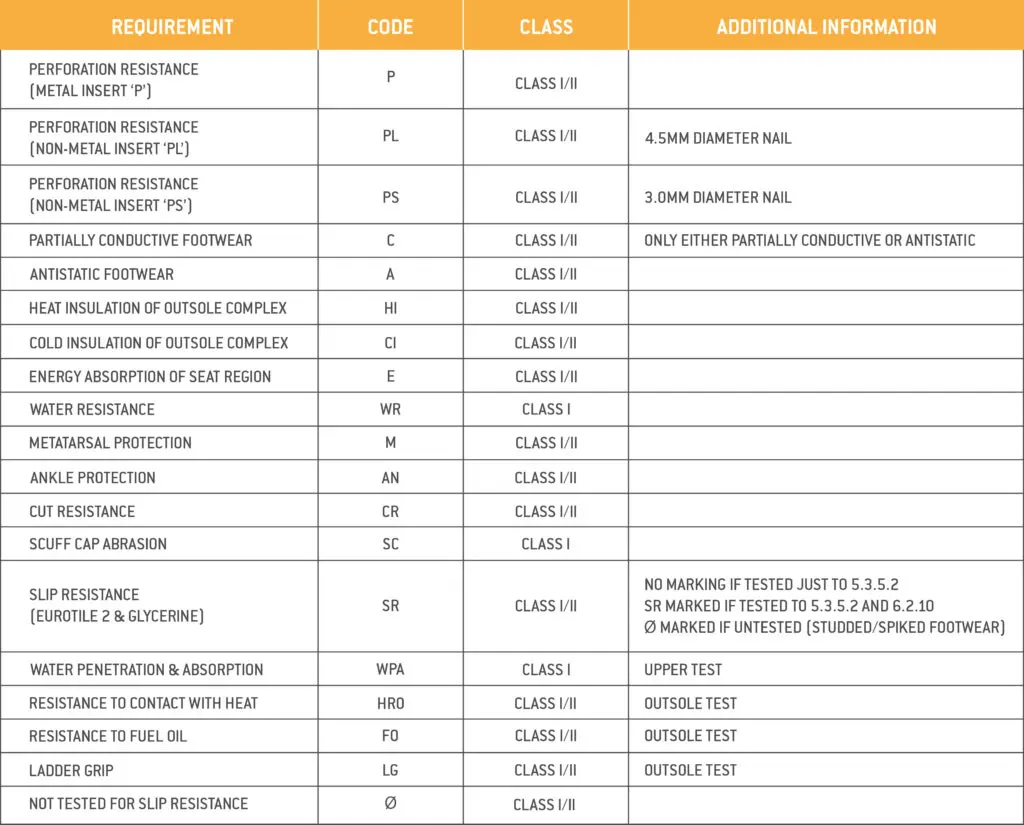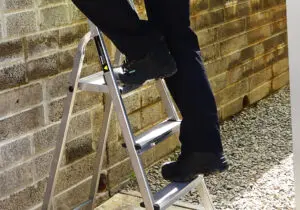EN ISO 20345:2022 Latest Changes
The updated Personal Protective Equipment – Safety Footwear Standard has been published and is due to supersede the previous 2011 update in 2024.
The changes to the standard can be categorised into ‘minor’ and ‘major’, with minor amendments affecting specific materials and/or markings, and major alterations affecting existing footwear that has been certified to the previous standard.
The test methods that the standard draws upon have also been revised, now under EN ISO 20344:2021.
Safety Footwear Standard Major Changes
There have been changes to the requirements and testing of slip resistance, as well as perforation-resistant inserts for non-metallic materials – both changes are classed as ‘major’.
Slip Resistance
Within the new standard, a new system has been developed for testing slip resistance to create a more accurate definition within the industry. As a result of this, the conditions of slip-resistance testing for safety footwear have changed. Footwear is now tested on a ceramic tile surface (Eurotile 2), rather than the previous steel plate, with the SLS (soapy water) and Glycerol lubricants (replicating oil-like substances). The Eurotile 2 replaces the previous stainless steel test surface (used for the old SRB and SRC ratings). Additionally, the flat foot test is no longer required, now testing the heel and forepart of the boot (referred to as the ‘backward forepart slip’).
Slip resistance testing is now mandatory, with the existing marks (SRA, SRB, SRC) now being redundant. An additional test can be carried out, however, indicated by the ‘SR’ marking. This marking is only shown if the following requirements are met:
-
- 5.3.5.2 – this refers to slip resistance tested on the Eurotile 2 with a soap solution and forms part of the basic requirement (there is no marking code used for this clause alone).
-
- 6.2.10 – this refers to slip resistance tested on the Eurotile 2 with a lubricant of glycerine (this test is optional, but must be carried out to meet the requirements necessary for claiming the ‘SR’ marking code)
Certain specialist footwear types including spikes, metal studs, or similar features may be exempt from the above slip testing, which will be highlighted by the marking ‘Ø’. Conventionally soled footwear, however, would have to achieve the basic requirement (5.3.5.2).
Puncture Resistance
The second major change to the Safety Footwear Standard is in relation to ‘puncture resistance’, previously referred to as ‘penetration resistance’. While the change to slip resistance testing impacts all safety footwear on the market, the changes to puncture resistance will only affect the footwear with non-metallic inserts claiming perforation resistance.
The change does not affect footwear with steel plate inserts, with the markings remaining ‘P’. For non-metallic inserts, however, there are two new tests, with the markings: ‘PL’ and ‘PS’. The difference between these two new tests is the diameter of the nail used, representing different environmental conditions.
The ‘PL’ marking indicates that a 4.5mm diameter nail was used during testing (the same as the previous 2011 ‘P’ test standard). A ‘PL’ marking specifies that the footwear is suitable for use in environments where there is a low/moderate chance of encountering nails.
The new ‘PS’ marking indicates that a 3mm diameter nail was used during testing. A ‘PS’ marking will likely be found on more specialist footwear where there is a high likelihood of encountering nails, or where the nails present may be narrower. In environments where sharps below 3mm will likely be encountered, it’s recommended to use steel midsoles.
During both tests, a nail is pushed through the sole unit containing all components with a force of no less than 1,100 N, with the upper removed. Separate standards are in place for the inserts as components themselves (‘Metallic perforation-resistant inserts’ – EN ISO 22568-3:2019; ‘Non-metallic perforation-resistant inserts’ – EN ISO 22568-4:2019).
Additional Changes to the Safety Footwear Standard
As well as the main changes detailed above, there are some additional, minor changes presented in the new EN ISO 20345:2022 standard.
Water Resistance
There is a new code for water-resistant uppers (WRU), ‘WPA’, which stands for ‘Water Penetration and Absorption’. The requirement for water resistance (clause 6.2.5) has also changed from ≤ 3cm2 to ‘no water penetration detected’.
Scuff Cap Abrasion Resistance Test
A new, optional, test, designed to assess the durability of the scuff cap protecting the toecap, has been introduced. The scuff cap must pass the test after 1,000 abrasion cycles before it can be marked with the symbol ‘SC’ (‘Scuff Cap’). This test ensures that the toe of the shoe is less susceptible to wear and tear.
Ladder Grip Test
Like the scuff cap abrasion test, this is a new, optional requirement in the 20345 standard. It is used to evaluate the suitability of safety footwear for ladder use by assessing according to criteria relating to design, cleat height in the waist area, and heel breast dimensions. All of which are similar to the EN 15090:2021 ‘Footwear for Firefighters’ standard.
Fuel Oil
Fuel oil testing is no longer mandatory for S-classification on safety footwear. If you’re likely to come into regular contact with fuel, you should check the standard version:
-
- EN ISO 20345:2011 S1 is tested on fuels
-
- EN ISO 20345:2022 S1 is not tested on fuels
You should check for the FO symbol or code if you’re likely to encounter hydrocarbons.
S6 and S7
The introduction of two new cut codes form part of the 2022 Safety Footwear Standard. You’ll likely see the code ‘S6’ used on products currently marked ‘S2 WR’, or ‘S7’ for products marked ‘S3 WR’ (i.e. their original category, plus water resistance). You can see more about classification changes in Table 1.
Area Changed for Ankle Protection Test
In the original test, the same area of the boot was used for the point of impact regardless of its size. However, this amendment means that the area absorbing the impact will change depending on the size of the boot, allowing for more accurate and representative results.
Classification and Certification Changes
There have been some changes in classification codes, as mentioned above, as well as some changes to markings, with additional marking codes being introduced (see Table 2). Fuel oil resistance is no longer required and has, therefore, been removed from group classifications (Table 1).

Table 1: Safety Footwear Standard Classification Changes

Table 2: Safety Footwear Standard Marking Codes (EN ISO 20345:2022)
What the changes mean for users
The 2022 Safety Footwear Standard has recently been harmonised in early June, with a transition period of 18 months. Currently, both the EN ISO 20345:2011 and 2022 standards are acceptable for new certifications up until November 2024. It’s important to note that, while no new footwear can be produced to the old standard beyond this date, the 2011 standards will remain valid for existing footwear until their designated expiry date (a maximum of five years after the certification date).
Therefore, for some time, we will see both new and old standards used to certify products on the market – to ensure that the footwear you’re using meets the requirements necessary for the work being carried out, you should check the relevant Safety Footwear Standard.
Once the transition period is complete and the expiry period of the 2011 standards has passed, you will no longer be able to purchase footwear certified to the old standard – it’s, therefore, vital that you understand the changes above to ensure you are purchasing the right safety footwear.
If we receive any additional information in relation to the obsolescence of the 2011 standard and its impact on end users, we will publish updates in the PWS Knowledge Hub.
To read more about the new EN ISO 20345:2022 Safety Footwear Standard, visit the International Organisation for Standardisation (ISO) website.
FAQs
The updated Safety Footwear Standard has now been published, meaning footwear can be tested to this standard. Footwear will specify which variation of the standard it has been tested to, and will carry the new codes if tested to the latest standard.
No. If footwear has recently been tested to the previous standard, this will be considered valid until the certification is due for renewal (5 years after the date of latest certification).
Yes. Footwear can be retested to the new standard within the five year renewal window if the manufacturer chooses to do so. As there is a cost implication, companies may choose to wait until their current certification expires, so you will still see the previous standard on some footwear up to 5 years beyond the introduction of the 2022 standard.
The new standards have now been harmonised, recognised by the European Committee for Standardisation. The EN 20354:2011 standard will be officially withdrawn from 11th November 2024 (footwear may be tested to this standard up until this date).
The Safety Footwear Standards have been changed to facilitate the following:
- More precise testing & clearer safety markings
- Testing will reflect more realistic safety conditions
- More accurate testing to accommodate new materials being used in footwear uppers
- More varied choice for the manufacturer & wearer to tailor footwear to specific risks
Ultimately, the new standards are in place to reduce workplace injury and keep people safe at work.
STAY INFORMED
Keep yourself informed and compliant through PWS’s Knowledge Hub. Through this regularly updated resource, we aim to keep you updated with legislation, H&S information and white papers like this one.
